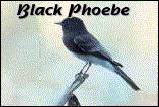

I would like to tell you about phoebes, probably the most likely bird you'll find feeding at your pond.
Phoebes are insect eating songbirds, members of the flycatcher family.
You've probably seen them perched on the rocks and foliage near your pond,
making little darts over to your pond's surface and then flying back to
just about the same perch. In the West, including Arizona and Texas, we
have Black Phoebes. Eastern Phoebes live on the other side of the Rockies
and occur only in the eastern 2/3 if the USA and parts of Canada. A third
Phoebe, the Say's, also is found in the West but is much less likely to
frequent your pond. I'm most familiar, as a Californian, with the Black
Phoebe, but most of this information applies to the Eastern species also.
The Black Phoebe has a black head, back, wings and tail with a white belly.
Easterns are less dramatically dressed and wear drabber shades
of grays and white. Their postures and mannerisms are much the same. All
three species engage in a behavior that somehow
seems charming and almost like a hello wave to us humans.


Both Black and Eastern Phoebes have a cheerful "fee-bee" call that they give ~20 - 40 times a minute. Common and easily observed, their fondness for our ponds is because they like to catch insects 'on the wing' as they rise from the water's surface or are caught on the surface (Yes, this would include damselflies as they emerge). Typically a Phoebe will visit the pond for 5-10 minutes for several brief sallies for prey into the air above the pond or to glean from the surface. Their diet is almost exclusively insects, but I wouldn't put it past them to snatch up a mosquito fish fry or two. Their nest is made of mud pellets and plant fibers and lined with grass, hair, and rootlets. They will nest under your eaves in a protected, quiet area if you provide a ledge for them to build upon. Otherwise they prefer to nest under bridges and in old barns.
One of my favorite remembrances of Black Phoebes is when ours fledged 5 young and papa perched them all in a row on a branch of our oak tree while he sallied back and forth, catching mosquitoes and gnats to feed them, each in turn. At the time I was raising one orphaned Phoebe who appeared to be the same age. He had really endeared himself to me by opening his black beak and, I swear, saying "Feed me, feed me!" But I realized the opportunity this papa Phoebe was providing me: I released my orphan and he immediately joined the other 5 fledglings on the oak branch. Luckily papa couldn't count that high and he fed him and trained him thereafter as if he was one of his own!
I hope you get to see a Phoebe at your pond soon. They are year-long residents. You can encourage them by placing a nesting shelf under your eaves and then providing them privacy if they do nest. Best of luck. I'd love to hear about your Phoebes: Kathy Biggs